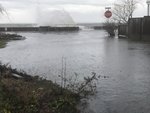


Following receipt of a letter from the Maple Beach Association (MBA) about flooding problems, Point Roberts Community Advisory Committee board chair Allison Calder believes it’s time to take action.
During storms and high water, the existing seawall is typically breached by water and debris subjecting low lying streets and homes to flooding. Some residents have suggested adding a topper to the wall which would deflect incoming waves backwards as seen on the seawall north of the border. Any such work would require county and state shoreline permitting that is difficult and time-consuming. “I’m not saying it’s impossible,” Calder said at the PRCAC meeting on January 19, “but it triggered me into looking for grants.”
Calder said there are federal and state grants available that could provide funding to replace existing vertical bulkheads with soft shoreline protection.
Bulkheads and seawalls can be detrimental for the health of the shoreline and concerns about their negative impact have inspired Washington state to push for soft shoreline development.
Soft shoreline development, also known as green shorelines or living shorelines, uses techniques that generally include some combination of native plantings, anchored drift logs, gravel berms, sand replenishment and site recontouring in areas that suffer from erosion or high wave energy. Soft shorelines look and feel natural and are constructed in a way that helps to prevent erosion.
“Because it (soft shoreline development) is what Washington state wants, the process of going through the U.S. Corp of Engineers, and departments of ecology and fish and wildlife is a lot easier and a lot smoother,” said Calder.
A similar project, the Birch Bay Drive and Pedestrian Facility Project, was completed in March 2021 after being first proposed by geologist Wolf Bauer in 1975. It took the county approximately 20 years of planning and permitting before work started in January 2020. The almost $16 million project involved removing cement groins and placing 205,000 tons of gravel and sand along the 1.6 mile stretch of beach. In contrast, the existing cement seawall on Bayview Drive is approximately 0.63 miles long.
One possible complication lies in the fact that immediately north of the border, the homes in Canada have vertical bulkheads similar to the existing seawall on Bayview. Past mitigation attempts to prevent undermining of the seawall by dumping loads of cobble stones have proved unsuccessful as the waves and currents washed the material northwards. Ideally, the county could work with the municipality of Delta on a coordinated approach to the problem.
The next step for the PRCAC is to have a meeting with the MBA to discuss options for a solution for the existing seawall. PRCAC nominated member Brian Hunter to represent them due to his background and work with drainage and stormwater
runoff.
Comments
No comments on this item Please log in to comment by clicking here